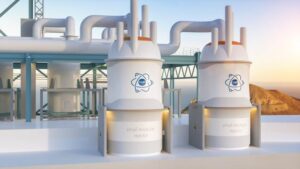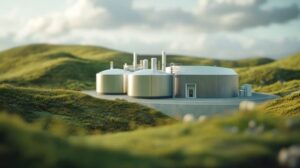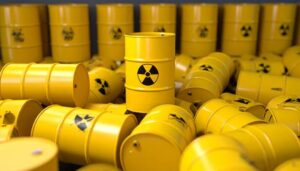
Rick Mills – “Small modular reactors gaining traction, powered by AI”
Opponents of nuclear power ignore a simple but powerful truth: nuclear is the only viable solution for the energy demands of the modern world.
While nuclear and renewable energies both offer low-carbon electricity generation, nuclear plants have the highest capacity factor, meaning they operate at maximum power 92% of the time.
The main disadvantage of wind and solar is the intermittency problem. They can only operate at full power during optimal weather conditions.
Nuclear reactors are expensive to build but they take up less land than renewables, especially solar.
Until the late 2000s, nuclear power (and uranium) was becoming a popular alternative to traditional fossil-fuel-based options.
But the Fukushima disaster of March 2011 soured the world on nuclear energy and the uranium industry. Triggered by a powerful offshore earthquake, tsunami waves disabled the plant’s cooling systems, causing three reactors to overheat and partially melt down, with subsequent releases of radioactive materials into the air and ocean.
Japan’s remaining nuclear reactors were closed for safety inspections, while a number of countries including Germany decided to phase out nuclear power.
The energy gap in Japan and Germany was filled by coal-fired power plants.
The fallout from Fukushima included a drop in uranium prices, with the market bottoming out near $30 a pound in mid-2014.
Nuclear revival
A revival began in 2022 with increased demand for nuclear and higher uranium prices. Some mothballed projects were restarted.
Financial Review ran a headline in September offering ‘3 reasons nuclear is now a booming industry’. Piggybacking on The Economist, they are: Western countries’ demand for an independent source of electricity; Big Tech’s thirst for green, reliable power; and novel financial models are driving a new wave of optimism.
A report out Wednesday by the International Energy Agency says electricity demand will rise much faster than energy growth in coming decades, underscoring the need for diversified sources. (Fortune)
The annual World Energy Outlook said solar power will grow the most and that coal and oil demand will peak at the end of the decade. Global nuclear capacity is set to increase by at least a third by 2035.
According to a January 2025 report by Goehring & Rozencwajg, a Wall Street commodities investment firm,
Over the past several years, we’ve had to increase our uranium demand estimates by nearly 40 million pounds as plant closures have been deferred and new-build plans have accelerated. With the introduction of SMRs [small modular reactors], offering even greater efficiency and safety, the nuclear industry is poised to take another transformative leap.
SMRs becoming more common
Oilprice.com describes SMRs as advanced nuclear reactors with a power capacity of up to 300 MW(e) per unit, equivalent to about one-third the generating capacity of a conventional nuclear reactor. SMRs are much smaller than traditional reactors and are modular, making it easier to assemble them in factories and transport them to the site. Because of their smaller size, SMRs can be installed on sites that are not suitable for conventional reactors. They are also significantly cheaper and faster to build than traditional nuclear reactors and can be constructed incrementally to meet the growing energy demand of a site…
In the U.S., an increasing number of tech companies are investing in SMR technology with the hopes of powering their high-energy-demand data centers with clean energy. The sector hopes SMR technology will be available to power several data centers by the 2030s, as their power demand grows in line with the rollout of artificial intelligence and other complex technologies. This has led Google to order seven SMRs, and Amazon, Microsoft, and Meta to follow suit…
In the Netherlands, the Nuclear Startup Thorizon announced a new consortium to develop a molten salt SMR. Thorizon has partnered with Dutch companies Demcon and VDL Group to set up an advanced testing facility to accelerate SMR technology development. The firm is currently building a 100-MW molten salt reactor, Thorizon One, which it hopes to get running in a pilot plant by the mid-2030s. It expects the first prototype to be fuelled by a mix of long-lived radioactive waste from existing nuclear facilities and thorium. This will transform much of the long-lived waste into short-lived waste.
Molten salt reactors are powered by a radioactive solution that blends fissionable isotopes with a liquid salt. While they can be powered using uranium, they run optimally on thorium, a cleaner, safer, and more abundant nuclear fuel. The reactor is expected to be safer and more efficient than water-cooled plants.
Big Tech goes nuclear
Google became the first company to sign an agreement with Kairos Power, a developer of molten salt-based SMRs.
G&R, the Wall Street firm, says the deal paves the way for up to 500 megawatts of nuclear-generated electricity to power Google’s data centers. According to Kairos’s press release:
“Having an agreement for multiple deployments is important to accelerate the commercialization of advanced nuclear energy by demonstrating the technical and market viability of a solution critical to decarbonization power grids while delivering much-needed energy generation and capacity.”
In other words, Google is not merely buying power; it is helping to usher in a new era of nuclear energy, states G&R in its report, ‘A New Dawn for Nuclear Power’.
Three nuclear companies are leading the race to build small nuclear reactors in the US. They are TerraPower, X-Energy and Kairos Power.
All of them are private but with significant financial backing, often from tech companies, and customers lined up, states CNBC.
TerraPower broke ground on its first plant, near a former coal site in Wyoming, in 2024. The company aims to start dispatching power by the end of 2030 to Warren Buffett’s PacifiCorp. The Natrium reactor has a power capacity of 345 megawatts, enough for more than 250,000 homes.
X-Energy secured hundreds of millions of dollars from Amazon to build its Xe-100 reactor. The Xe-100 is an 80-megawatt reactor sold in a pack of four units to construct 320 megawatts in total.
Amazon’s investment will finance four Xe-100 reactors in Washington state that will be built, owned and operated by Energy Northwest, a utility, with plants coming online in the early 2030s. The intent is to scale up to a dozen Xe-100s in Washington.
X-Energy is also working with Dow to deploy four reactors at the chemical company’s manufacturing in Seadrift, Texas, CNBC states.
Kairos Power signed a contract with Alphabet’s Google unit last year to deploy multiple advanced reactors, aiming to supply YouTube with 500 megawatts of power. The first reactor is expected to come online in 2030, with additional deployments through 2035.
CNBC notes the 75-megawatt Kairos’ reactor will be deployed in pairs to provide 150 megawatts of total power. Kairos is building a low-power, demonstration reactor in Oak Ridge, Tennessee to showcase its ability “to deliver clean, safe, and affordable nuclear heat.” Oak Ridge was where uranium was enriched as part of the Manhattan Project to build the first atomic bombs.
SMRs in Canada
The SMR wave is also barreling into Canada. In May of this year, the Ontario government gave Ontario Power Generation the green light to start construction on Canada’s first small modular reactor, to be built next door to the Darlington power plant. It would be the first of four SMRs budgeted at CAD$20.9 billion.
The first commercial grid-scale SMR in North America would provide 300 megawatts of power, enough electricity to supply about 300,000 homes, according to briefing documents from Ontario’s Ministry of Energy and Mines.
Ontario has always been big on nuclear, deriving half of its electricity from nuclear power and 25% from hydroelectricity.
Demand for power across Ontario is set to increase 75% by 2050.
According to CBC News, The estimated construction cost of the initial reactor is $7.7 billion, which includes $1.6 billion of infrastructure to be shared across the project…
Ontario would become the first place in the world to build the BWRX-300, which is a smaller version of GE Hitachi’s existing boiling water reactor technology…
The timeline is to finish construction of the first reactor by the end of 2029 and connect it to the grid in 2030.
In fact the BWRX-300 is the product of a joint venture between US industrial company GE Vernova (GEV) and Japanese conglomerate Hitachi, Barron’s said in June. CNBC noted a year ago that the General Electric spinoff is targeting more than $2 billion in annual revenue from its small-reactor business by the mid-2030s. The company sees demand for as many as 57 small reactors in total across its target markets in the US, Canada, the United Kingdom and Europe by 2035.
Along with Ontario, SMRs could also be coming to Alberta, with a focus on powering the province’s oil and gas sector.
A study by X-energy Canada has confirmed the feasibility and benefits of repurposing an existing thermal generation site with X-energy’s small modular reactors, World Nuclear News reported in September.
Funded by Emissions Reduction Alberta (ERA), the study found that the Xe-100 high-temperature gas-cooled reactor is uniquely suited to Alberta’s energy needs. As well as producing electricity, it is specifically designed to provide 565°C heat and steam for industrial applications, unlocking a broad range of use cases for Alberta’s industrial and oil and gas sectors, the company said. The province’s established supply chain capabilities are well-positioned to support the manufacturing and construction of the technology, while the Xe-100’s design means it can use air-cooling systems, significantly reducing overall water usage, and offering greater siting flexibility over conventional light-water reactors.
Nuclear-powered container ship
Small modular reactor technology has improved immensely in recent years, with some surprising innovations.
China is developing the prototype for a container ship powered by a thorium-fueled nuclear reactor — a world first.
The vessel under development would have a 200-megawatt thorium molten salt reactor (TMSR) and is capable of carrying up to 14,000 standard shipping containers. According to the South China Morning Post, that would make it one of the largest and most advanced nuclear-powered cargo ships ever built.
Other key points in the article posted by DieselNet:
- The announcement highlights China’s push to apply thorium-based nuclear technology beyond land-based reactors, extending it into a mobile, compact maritime platform. The vessel’s reactor uses 232Th that breeds uranium 233U, the actual fissile material, through a neutron absorption process.
- The 200 MW output of the TMSR reactor matches the power level of the S6W pressurized water reactor used in the US Navy’s most advanced Seawolf-class nuclear attack submarines.
- The system eliminates the need for vast volumes of high-pressure steam and cooling water, making it more compact and theoretically safer.
- The project builds on China’s earlier success with the TMSR-LF1—a 2 MW experimental molten salt reactor completed in Gansu province in 2021.
- If successful, the thorium-powered vessel could dramatically reduce global shipping emissions and extend the ship’s range between refueling. A thorium reactor produces no GHG emissions during operation and can run continuously for several years before refueling.
In another technological leap forward, Chinese scientists say they have, in a lab setting, converted thorium into fissile uranium‑233 inside a running molten‑salt loop. This proves that the fuel cycle can close in real conditions, thus reviving a path the United States opened in the 1960s and then walked away from, largely for strategic reasons, states an article on the experiment:
The Shanghai Institute of Applied Physics reports a successful thorium-to‑uranium‑233 conversion inside a high‑temperature loop of molten salts at about 750 °C. The fuel sits dissolved in the liquid, not packed into rods. Neutrons do the transmutation work. Engineers measured the build‑up of U‑233, the isotope that can sustain a chain reaction.
There is no turbine, no concrete dome and no pressurised water circuit. The unit runs near atmospheric pressure. It is a platform to validate chemistry, materials and neutronics. Yet it points to a reactor family that can produce electricity and industrial heat without relying on mined uranium as the primary input.
The case for thorium and MSRs
While conventional nuclear power plants are only able to extract 3-5% of the energy in uranium fuel rods, in molten salt reactors (MSR) favored by thorium proponents, nearly all the fuel is consumed.
A key advantage of MSRs is the reactor cannot melt down, as we saw in Japan’s Fukushima when electric pumps were inundated by the tsunami, failing to cool the fuel rods, which overheated and caused radiation emissions. MSRs can also be made cheaper and smaller than conventional reactors, since they do not have large, pressurized containment tanks, meaning they could be used in factory settings.
Where radioactive waste from uranium-based reactors lasts up to 10,000 years, residues from the thorium reaction will become inert within 500. Nuclear waste (i.e. plutonium) from uranium-fueled reactors can be recycled to recover the fissile materials needed to create the nuclear reaction. In this way, thorium reactors not only generate less waste than conventional reactors but also help to rectify the nuclear waste disposal problem.
Importantly, because plutonium is not created as a waste product in a thorium reactor, it cannot be separated from the waste and used to make nuclear weapons.
The portability of MSRs is another major advantage over the capital-intensive, permanent nuclear power plants we currently have.
Other than the fact that uranium is better than thorium in building nuclear weapons, how do the two nuclear fuels stack up against one another? According to the Royal Society of Chemistry, thorium’s benefits include:
- Thorium is three to four times more abundant than uranium. There is estimated to be enough thorium on the planet to last 10,000 years.
- Thorium is more easily extracted than uranium.
- Liquid fluoride thorium reactors (LFTR) – a type of molten salt reactor — have very little waste compared with reactors powered by uranium.
- It is more efficient. One tonne of thorium delivers the same amount of energy as 250 tonnes of uranium.
- LFTRs run at atmospheric pressure instead of 150 to 160 times atmospheric pressure currently needed for water-cooled reactors.
- Thorium is less radioactive than uranium.
Uranium boom
Like the nuclear industry, G&R says the uranium market is also on the cusp of a remarkable transformation.
Uranium is benefiting from a paucity of supply compared to demand.
Current global uranium usage is about 180 million pounds a year. But mines only produce 130 million pounds, leaving a 50-million-pound shortage. The industry is covering the shortage by delving into stockpiles, but those stockpiles are running out.
Meanwhile, demand is about to explode, with the World Nuclear Association projecting uranium demand will jump 28% by 2030.
A Mining.com infographic identifies which regions host the most nuclear reactors in operation and under construction, and how much uranium is required to keep them running.
Globally there are 438 operating reactors, with East Asia edging out North America by 117 to 113. Third is the European Union at 99. East Asia has by far the most under construction at 38. North America has none being built.
By 2030, East Asia will have the most installed nuclear generating capacity, @ 157.8 Gwe net, and the most annual reactor-related uranium requirements @ 25,448 tonnes U/yr. Next is North America, followed by the European Union, non-EU Europe, the Middle East, Central Asia and South Asia grouping, and Africa.
The US government is goosing demand even more, by partnering with Westinghouse Electric to build at least $80 billion in nuclear reactors. The agreement is with Westinghouse Electric’s owners, Canadian uranium miner Cameco and Brookfield Asset Management.
Investing.com states the deal could add another 15-20 million pounds of annual demand once those reactors are built in the 2030s. Add in 31 countries pledging to triple their nuclear capacity by 2050, plus tech companies like Microsoft and Amazon racing to secure nuclear power for their AI data centers, and you have a supply crisis in slow motion.
Uranium prices are already reflecting this reality. After bottoming at $64 per pound in March, prices jumped 29% to reach $82 by September. Some recent contracts are locking in prices of $125-130 per pound with $70-75 floor guarantees. Banks like Citi are projecting uranium will hit $110 per pound by 2026.
Source: Trading Economics
Conclusion
Uranium prices are always influenced by the demand for nuclear power, and that demand is increasing, particularly for small modular reactors that, as we have explained, offer several advantages over conventional nuclear reactors.
To recap, while they can only generate about one-third the power of a traditional reactor, SMRs are easy to assemble and move, making them appropriate for remote industrial sites or even for commercial shipping vessels — though the latter is in its early stages.
They are also significantly cheaper and faster to build and can be constructed in stages to meet the growing energy demands of a site.
SMRs are becoming more popular in Canada and the United States, with the first commercial grid-scale SMR in North America — one of four— to be built in Ontario next to an existing nuclear power plant.
Demand for them is being driven by the exponential increase in computing power demanded by artificial intelligence, particularly data centers. A single hyperscale data center can demand 100 megawatts or more, with a monthly consumption equivalent to the annual electricity demand of thousands of homes. (AI Overview)
Big Tech sees nuclear as the solution to their electricity needs and is investing billions of dollars in both conventional nuclear and SMRs.
In 2024 Google ordered seven SMRs, with Amazon, Microsoft and Meta expected to follow suit.
G&R notes Microsoft partnered with Constellation Energy to reopen the Three Mile Island Unit 1 reactor which has been shuttered since 2019. In September, Holtec International secured a $1.5 billion loan guarantee from the US Department of Energy to reopen the 800-megawatt Palisades Nuclear Plant in Michigan which had ceased operations in 2022. The company plans to install two SMRs on the site, adding 600 megawatts of new capacity.
Google became the first company to sign an agreement with Kairos Power, a developer of molten salt-based SMRs. The deal paves the way for up to 500 megawatts of nuclear-generated electricity to power Google’s data centers.
Meta is reportedly exploring various deals for carbon-free energy, with SMRs high on the list.
SMRs powered by thorium are the future of nuclear energy. In molten salt reactors (MSR) favored by thorium proponents, nearly all the fuel is consumed, compared to just 3-5% of the energy in uranium fuel rods.
Thorium is more abundant, more easily extracted, generates less waste, is safer, more efficient, and less radioactive than uranium.
Thorium is what we should be using in small nuclear reactors instead of most other forms of energy.
Richard (Rick) Mills
aheadoftheherd.com
Subscribe to AOTH’s free newsletter
Legal Notice / Disclaimer
Ahead of the Herd newsletter, aheadoftheherd.com, hereafter known as AOTH.
Please read the entire Disclaimer carefully before you use this website or read the newsletter. If you do not agree to all the AOTH/Richard Mills Disclaimer, do not access/read this website/newsletter/article, or any of its pages. By reading/using this AOTH/Richard Mills website/newsletter/article, and whether you actually read this Disclaimer, you are deemed to have accepted it.
Any AOTH/Richard Mills document is not, and should not be, construed as an offer to sell or the solicitation of an offer to purchase or subscribe for any investment.
AOTH/Richard Mills has based this document on information obtained from sources he believes to be reliable, but which has not been independently verified.
AOTH/Richard Mills makes no guarantee, representation or warranty and accepts no responsibility or liability as to its accuracy or completeness.
Expressions of opinion are those of AOTH/Richard Mills only and are subject to change without notice.
AOTH/Richard Mills assumes no warranty, liability or guarantee for the current relevance, correctness or completeness of any information provided within this Report and will not be held liable for the consequence of reliance upon any opinion or statement contained herein or any omission.
MORE or "SLIDER"
Prospector Podcast - Kai Hoffmann: Mining Sector Financing Surge & Junior Mining Trends
Michael Fox, host of the Prospector Podcast, sat down with Kai Hoffmann of SOAR Financial to ... READ MORE
Rick Mills - "Building the case for Thorium powered SMRs" (Video)
Where radioactive waste from uranium-based reactors lasts up to 10,000 years, residues from t... READ MORE
Honey Badger Identifies Two New Zones: Inferno and Pimento Containing Silver, Gold, Lead, and Zinc at Plata, Yukon
Honey Badger Silver Inc. (TSX-V: TUF) (OTCQB: HBEIF) is pleased to announce that the Company has id... READ MORE
CUPANI Metals Announces Non-Brokered Private Placement
CUPANI METALS CORP. (CSE: CUPA) (OTCQB: CUPIF) is pleased to announce its intention to raise up to C... READ MORE

























